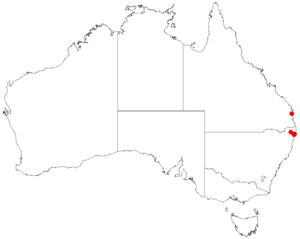Swamp mint-bush facts for kids
Quick facts for kids Swamp mint-bush |
|
|---|---|
| Conservation status | |
| Scientific classification | |
| Genus: |
Prostanthera
|
| Species: |
palustris
|
 |
|
| Occurrence data from AVH | |
The Swamp mint-bush (scientific name: Prostanthera palustris) is a special flowering plant. It belongs to the Lamiaceae family, which includes mints. This plant is only found in a small part of New South Wales, Australia. It's a low, spreading bush that doesn't grow very tall. It has unique leaves shaped like spatulas. Its flowers are a pretty pale mauve and white, with cool yellow spots inside.
Contents
What the Swamp Mint-Bush Looks Like
The Swamp mint-bush is a small, spreading shrub. It usually grows to be about 20 to 30 centimeters (8 to 12 inches) tall. This plant does not have a strong smell like some other mint plants. Its branches have two small ridges along them.
Its leaves are a dull green on top and lighter underneath. They are shaped like a spatula, which is wide at the end and narrow at the base. Each leaf is about 4 to 6 millimeters long and 3.5 to 5 millimeters wide. They grow on a short stalk called a petiole, which is about 1 to 2 millimeters long.
The flowers grow in small groups of four to ten. They appear where the leaves meet the stem. Each flower sits on a tiny stalk called a pedicel, which is about 0.5 to 1.5 millimeters long.
The flowers have light green sepals, which are like small leaves that protect the bud. These sepals form a tube about 2.5 to 3 millimeters long. They have two parts, or lobes. The lower lobe is about 1.5 to 3 millimeters long, and the upper lobe is about 1.5 to 2 millimeters long.
The petals are pale mauve and white, with yellow dots inside the tube part. The whole petal structure is about 8 to 10 millimeters long. It forms a tube about 4 millimeters long with two "lips." The middle part of the lower lip is about 4 to 4.5 millimeters long and 4.5 to 5 millimeters wide. The side parts are about 4 millimeters long and 2.5 millimeters wide. The upper lip is about 2.5 millimeters long and 6 to 6.5 millimeters wide.
This plant mostly flowers from February to June.
How the Swamp Mint-Bush Got Its Name
The Swamp mint-bush, Prostanthera palustris, was first officially described in 1997. A scientist named Barry Conn wrote about it in a science journal called Telopea. He studied plants that were collected in Bundjalung National Park in 1990.
Where the Swamp Mint-Bush Lives
The Swamp mint-bush grows in wet areas near the coast. You can find it in shrubland and heathland habitats. It lives specifically in Bundjalung National Park in New South Wales.
Protecting the Swamp Mint-Bush
The Swamp mint-bush is considered "vulnerable." This means it is at risk of disappearing if we don't protect it. Both the Australian Government and the New South Wales Government have laws to protect it.
The biggest dangers to this plant include:
- Wrong Fire Management: Fires that happen too often or at the wrong time can harm the plants.
- Trampling: People or animals walking on the plants can damage them.
- Clearing Land: When land is cleared for building or farming, the plant loses its home.
Protecting these areas helps the Swamp mint-bush survive and thrive.


